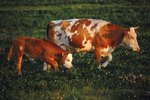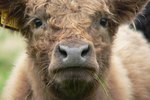If your cattle develop circular lesions on their skin, odds are they're suffering from ringworm. It's a common skin issue in bovines, and quite contagious. Although ringworm eventually will go away without treatment, that can take months -- and the affected cattle can continue spreading the fungus.
Warnings
Ringworm is a zoonotic disease. That means it can spread between species, and you can pick up the fungus from your livestock. Wear disposable gloves when treating ringworm or handling an infected animal. Wash your hands thoroughly after contact with such cattle.
Signs of Ringworm
While most often found on the animal's neck and head, ringworm can appear anywhere on the body. The older the cow, the more likely the lesions to appear elsewhere, especially the legs and chest. However, calves and young stock are more vulnerable to the fungus, as older cattle generally develop some immunity. Beside the telltale circular lesions -- where the misnomer "ringworm" originated -- signs of ringworm include:
- Grayish skin patches
- Hairless patches of skin
- Crusty round scabs, which may become quite large.
Ringworm Treatment
Your vet may prescribe a topical ointment to treat ringworm or recommend an over-the-counter product.
- Ask your vet about using diluted chlorine bleach or iodine to treat the fungus. If she agrees, she'll give you the proper dilution ratio.
- Using either topical medication or the time-honored methods of diluted bleach or chlorine involves washing the scabs with a disinfectant soap and using a hard brush to remove the scabs from the animal.
-
You must collect and dispose of the skin and hair taken off the cow. Place the debris in a plastic bag and put it another plastic trash bag to throw it out. If it's permitted in your area, you
also can burn the debris. Place the topical medication or diluted chlorine or iodine on the cow after the scabs are removed.
* Topical medication usuallyis applied a few times, with an interval of several days between applications. Your vet will let you know how often to apply diluted disinfectants.
Preventing Ringworm
Avoidance is always preferable to treatment. Basic prevention practices include:
- Avoid using the same equipment, including halters and brushes, on different cattle. If that's not possible, regularly dip brushes and similar items in a solution of 1 part bleach to 10 parts water.
- Keep your cattle outdoors as much as possible, especially on sunny days. Cattle housed inside are more likely to come into contact with ringworm spores, and sunlight really is the best disinfectant.
- Vitamin A inhibits the growth of ringworm. Make sure there are sufficient amounts of it in your herd's feed.
Tips
If you exhibit your cattle at a fair or otherwise take them off your property where they are exposed to strange livestock, give them a good anti-fungal bath when you bring them home. If possible, isolate them from other herd members for a few weeks. If you planned to exhibit your cattle and a member of the herd develops ringworm, cancel your plans. You can't bring a cow with ringworm to a fair.
Writer Bio
Jane Meggitt has been a writer for more than 20 years. In addition to reporting for a major newspaper chain, she has been published in "Horse News," "Suburban Classic," "Hoof Beats," "Equine Journal" and other publications. She has a Bachelor of Arts in English from New York University and an Associate of Arts from the American Academy of Dramatics Arts, New York City.





